engine overheat MERCEDES-BENZ SLS AMG GT COUPE 2015 C197 Owner's Manual
[x] Cancel search | Manufacturer: MERCEDES-BENZ, Model Year: 2015, Model line: SLS AMG GT COUPE, Model: MERCEDES-BENZ SLS AMG GT COUPE 2015 C197Pages: 290, PDF Size: 6.24 MB
Page 137 of 290
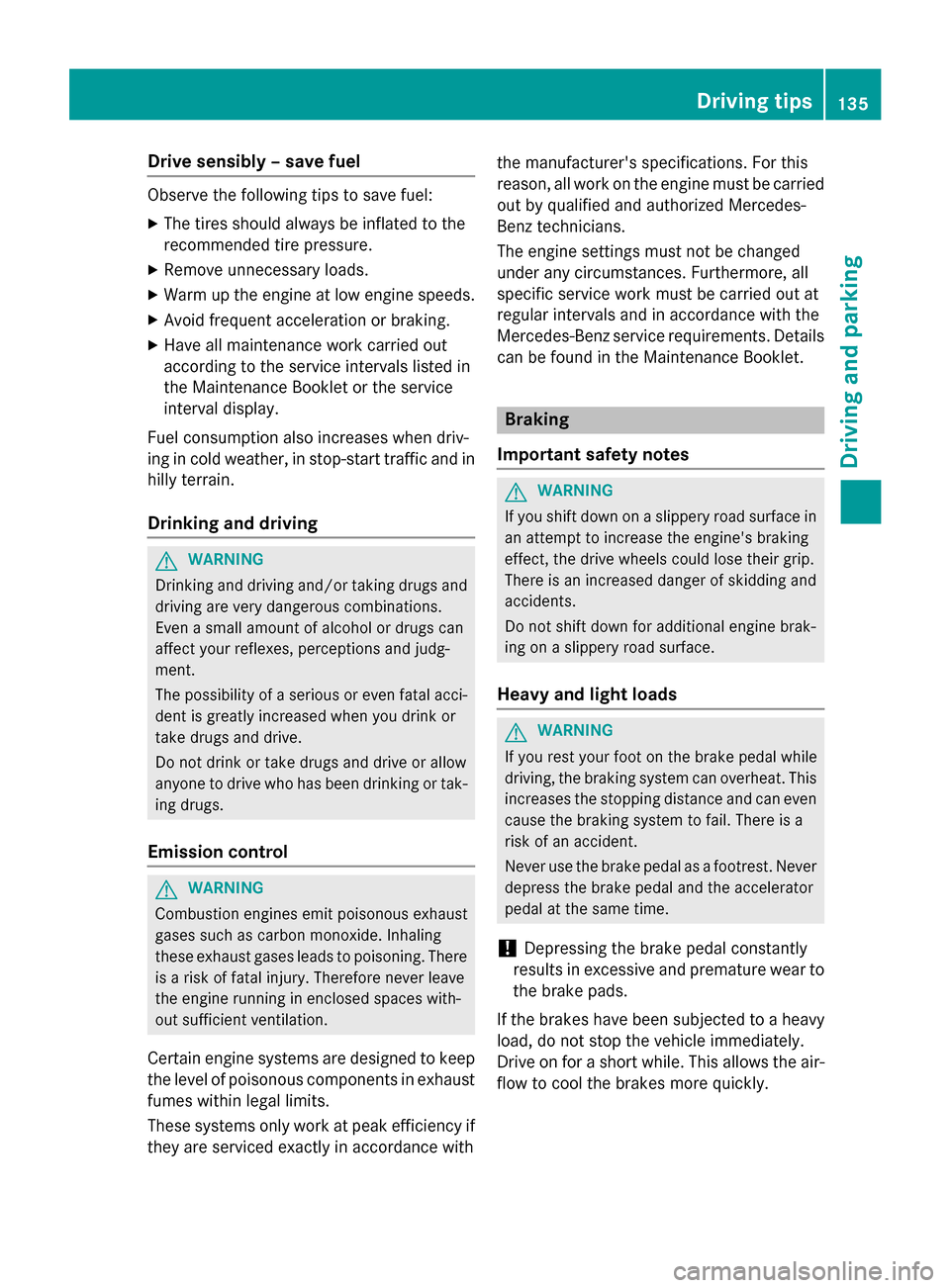
Drive sensibly
–savef uel Observ
ethe following tips to sav efuel:
X The tires should always be inflated to the
recommended tire pressure.
X Remov eunnecessary loads.
X War mupt heengin eatlow engin espeeds.
X Avoid frequent acceleration or braking.
X Hav eall maintenance wor kcarrie dout
accordin gtotheservic einterva ls listed in
th eM aintenance Booklet or th eservice
interval display.
Fue lconsu mption also increase swhen driv-
in ginc oldw eather ,instop-start traffic and in
hill yterra in.
Drinking an ddriving G
WARNING
Drinking and drivin gand/o rtaking drugs and
drivin gare ver ydangerous combinations.
Even asma ll amount of alcoho lordrugs can
affec tyour reflexes, perception sand judg-
ment.
The possibilit yofas erious or eve nfatal acci-
den tisg reatly increase dwhen you drink or
take drugs and drive.
Do no tdrink or take drugs and drive or allow
anyon etodrive who has bee ndrinkin gortak-
in gd rugs.
Emission control G
WARNING
Combustion engines emi tpoisonous exhaust
gases suc hascarbon monoxide. Inhaling
these exhaus tgases lead stopoisoning. There
is ar iskoff atal injury. Therefor enever leave
th ee nginer unning in enclose dspaces with-
out sufficien tventilation.
Certain engin esystems are designed to keep
th el evel of poisonous component sinexhaust
fumes within lega llimits.
These systems only wor katpeak efficiency if
they are serviced exactly in accordance with th
em anufacturer's specifications. Fo rthis
reason ,all wor kont heengin emustbec arried
out by qualified and authorized Mercedes-
Benz technicians.
The engin esetting smustn otbe changed
under any circumstances. Furthermore, all
specific servic eworkm ustbec arriedout at
regular intervals and in accordance wit hthe
Mercedes-Ben zservic erequirements .Detai ls
can be found in th eMaintenance Booklet. Braking
Important safet ynotes G
WARNING
If you shift down on aslipper yroads urfac ein
an attempt to increase th eengine's braking
effect ,the drive wheels could los etheir grip.
There is an increase ddanger of skidding and
accidents.
Do no tshift down fo radditional engin ebrak-
in gonas lipperyroads urface.
Heavy an dligh tloads G
WARNING
If you res tyour foot on th ebrake peda lwhile
driving, th ebraking system can overheat .This
increase sthe stoppin gdistanc eand can even
cause th ebraking system to fail .There is a
ris kofana ccident.
Never use th ebrake peda lasafootrest. Never
depress th ebrake peda land th eaccelerator
peda latthesam etime.
! Depressing th
ebrake peda lconstantly
result sinexcessive and premature wear to
th eb rake pads.
If th ebrake shaveb een subjecte dtoa heavy
load ,don otstop th evehicle immediately.
Drive on fo rashort while. Thi sallow sthe air-
flo wt ocoolthe brake smoreq uickly. Driving tips
135Driving andpark ing Z
Page 140 of 290
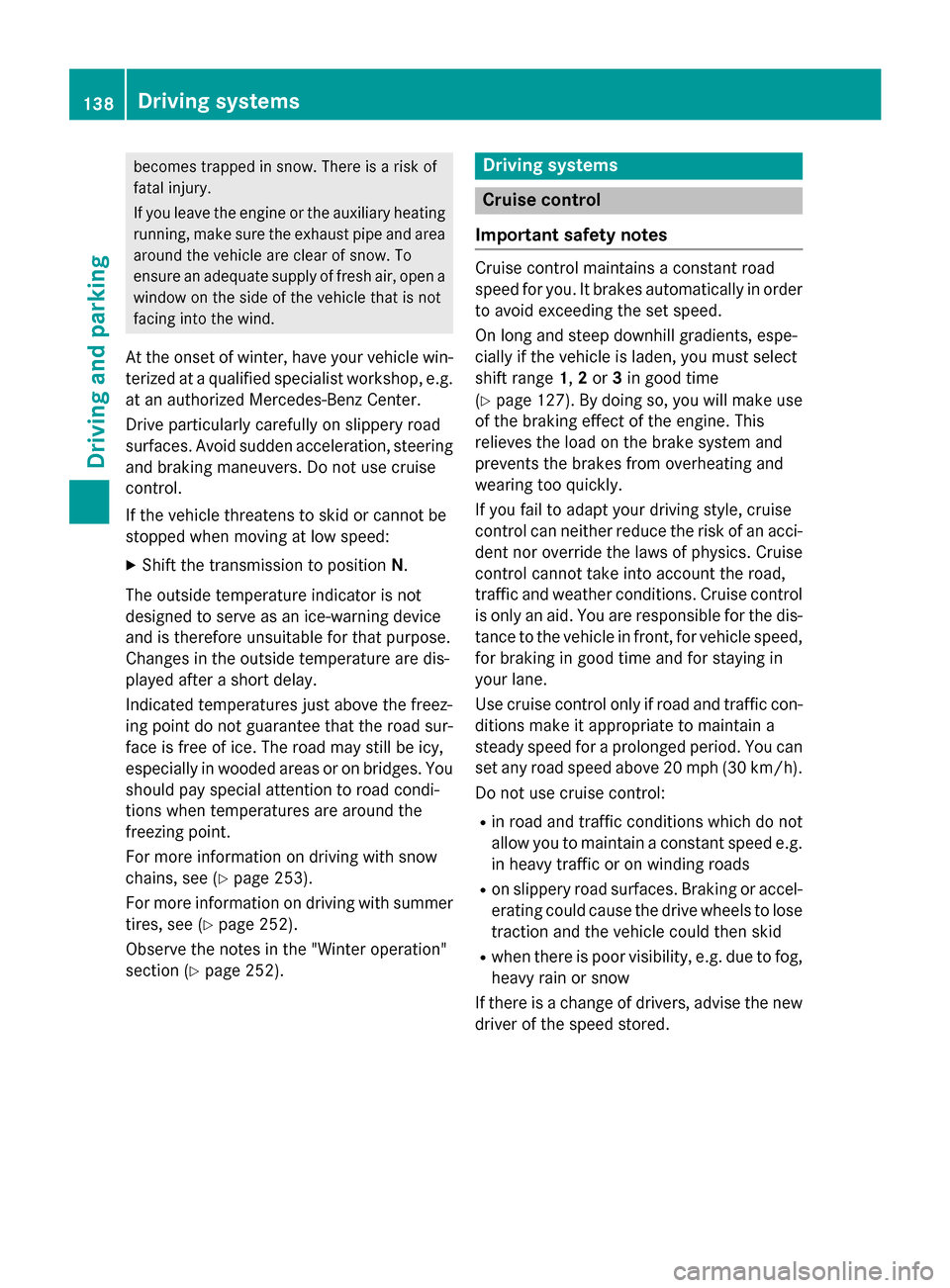
becomes trapped in snow. There is
arisk of
fatal injury.
If you leave the engin eorthe auxiliary heating
running, make sure the exhaust pipe and area
around the vehicle are clear of snow. To
ensure an adequate supply of fresh air, open a window on the side of the vehicle that is not
facin gintot he wind.
At the onset of winter ,have your vehicle win-
terized at aqualified specialist workshop, e.g.
at an authorized Mercedes-Benz Center.
Driv eparticularly carefully on slippery road
surfaces. Avoid sudden acceleration, steering
and brakin gmaneuvers. Do not use cruise
control.
If the vehicle threatens to skid or cannot be
stopped when movin gatlow speed:
X Shift the transmission to position N.
The outside temperature indicator is not
designed to serve as an ice-warning device
and is therefore unsuitable for that purpose.
Changes in the outside temperature are dis-
played after ashort delay.
Indicated temperatures just above the freez-
ing point do not guarantee that the road sur-
face is free of ice. The road may still be icy,
especially in wooded areas or on bridges. You
should pay special attention to road condi-
tion swhen temperatures are around the
freezing point.
For more information on driving with snow
chains, see (Y page 253).
For more information on driving with summer tires, see (Y page 252).
Observe the notes in the "Winter operation"
section (Y page 252). Driving systems
Cruise control
Important safet ynotes Cruise contro
lmaintains aconstan troad
speed for you. It brakes automatically in order
to avoid exceeding the set speed.
On long and steep downhill gradients, espe-
cially if the vehicle is laden, you must select
shift range 1,2or 3in good time
(Y page 127). By doing so, you will make use
of the brakin geffec toft he engine. This
relieves the load on the brake system and
prevents the brakes from overheating and
wearing too quickly.
If you fail to adapt your driving style, cruise
contro lcan neither reduce the risk of an acci-
dent nor override the laws of physics. Cruise
contro lcannot take int oaccoun tthe road,
traffic and weather conditions. Cruise control
is only an aid. You are responsible for the dis-
tanc etot he vehicle in front, for vehicle speed,
for brakin gingood time and for staying in
your lane.
Use cruise contro lonly if road and traffic con-
dition smake it appropriate to maintain a
steady speed for aprolonge dperiod. You can
set any road speed above 20 mph (30 km/h).
Do not use cruise control:
R in road and traffic condition swhich do not
allow you to maintain aconstan tspeed e.g.
in heavy traffic or on winding roads
R on slippery road surfaces. Braking or accel-
eratin gcould cause the drive wheels to lose
traction and the vehicle could then skid
R when ther eispoor visibility, e.g. due to fog,
heavy rain or snow
If ther eisac hangeofd rivers, advise the new
driver of the speed stored. 138
Driving systemsDriving and parking
Page 170 of 290
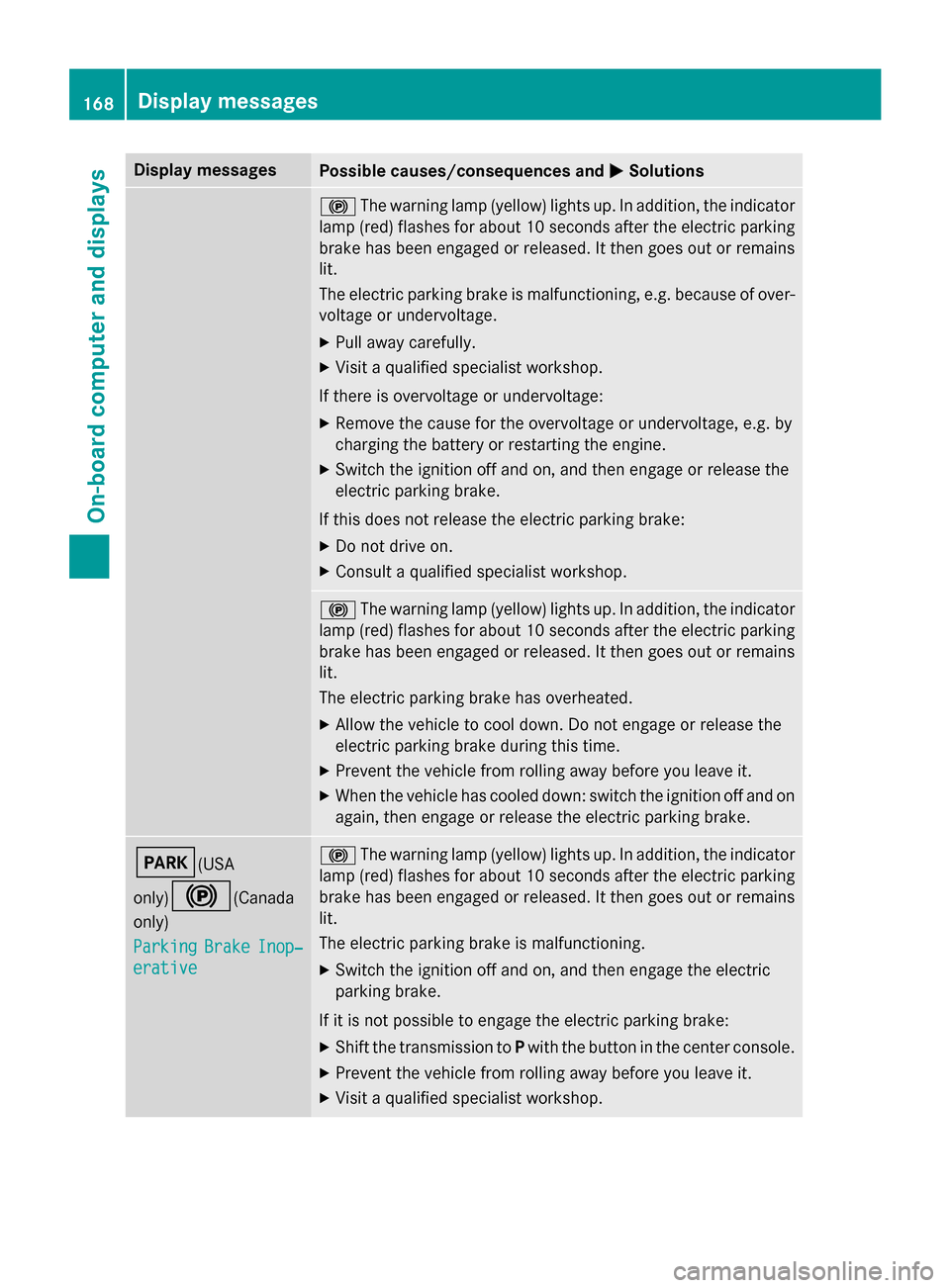
Display messages
Possible causes/consequences and
0050
0050Solutions 0024
The warnin glamp (yellow) lights up. In addition ,the indicator
lamp (red) flashes fo rabout 10 seconds after th eelectric parking
brak ehas been engage dorreleased. It then goe sout or remains
lit.
The electric parkin gbrak eism alfunctioning, e.g. because of over-
voltag eorundervoltage.
X Pull away carefully.
X Visit aqualified specialist workshop.
If there is overvoltage or undervoltage: X Remove th ecaus efor theo vervoltage or undervoltage, e.g. by
chargin gthe battery or restarting th eengine.
X Switc hthe ignition of fand on ,and then engage or release the
electric parkin gbrake.
If this does no trelease th eelectric parkin gbrake:
X Do no tdrive on.
X Consult aqualified specialist workshop. 0024
The warnin glamp (yellow) lights up. In addition ,the indicator
lamp (red) flashes fo rabout 10 seconds after th eelectric parking
brak ehas been engage dorreleased. It then goe sout or remains
lit.
The electric parkin gbrak ehas overheated.
X Allow th evehicl etoc ooldown .Don otengage or release the
electric parkin gbrak eduring this time.
X Preven tthe vehicl efromr ollin gaway before you leav eit.
X Whe nthe vehicl ehas cooled down :switch th eignition of fand on
again ,the ne ngage or release th eelectric parkin gbrake. 0049(USA
only)0024
(Canada
only)
Parking Parking Brake
BrakeInop‐
Inop‐
erative
erative 0024
The warnin glamp (yellow) lights up. In addition ,the indicator
lamp (red) flashes fo rabout 10 seconds after th eelectric parking
brak ehas been engage dorreleased. It then goe sout or remains
lit.
The electric parkin gbrak eism alfunctioning.
X Switc hthe ignition of fand on ,and then engage th eelectric
parkin gbrake.
If it is no tpossibl etoengage th eelectric parkin gbrake:
X Shift th etransmissio ntoPwith th ebutto nint hecenter console.
X Preven tthe vehicl efromr ollin gaway before you leav eit.
X Visit aqualified specialist workshop. 168
Display
messagesOn-boardcomputer an ddisplays
Page 179 of 290
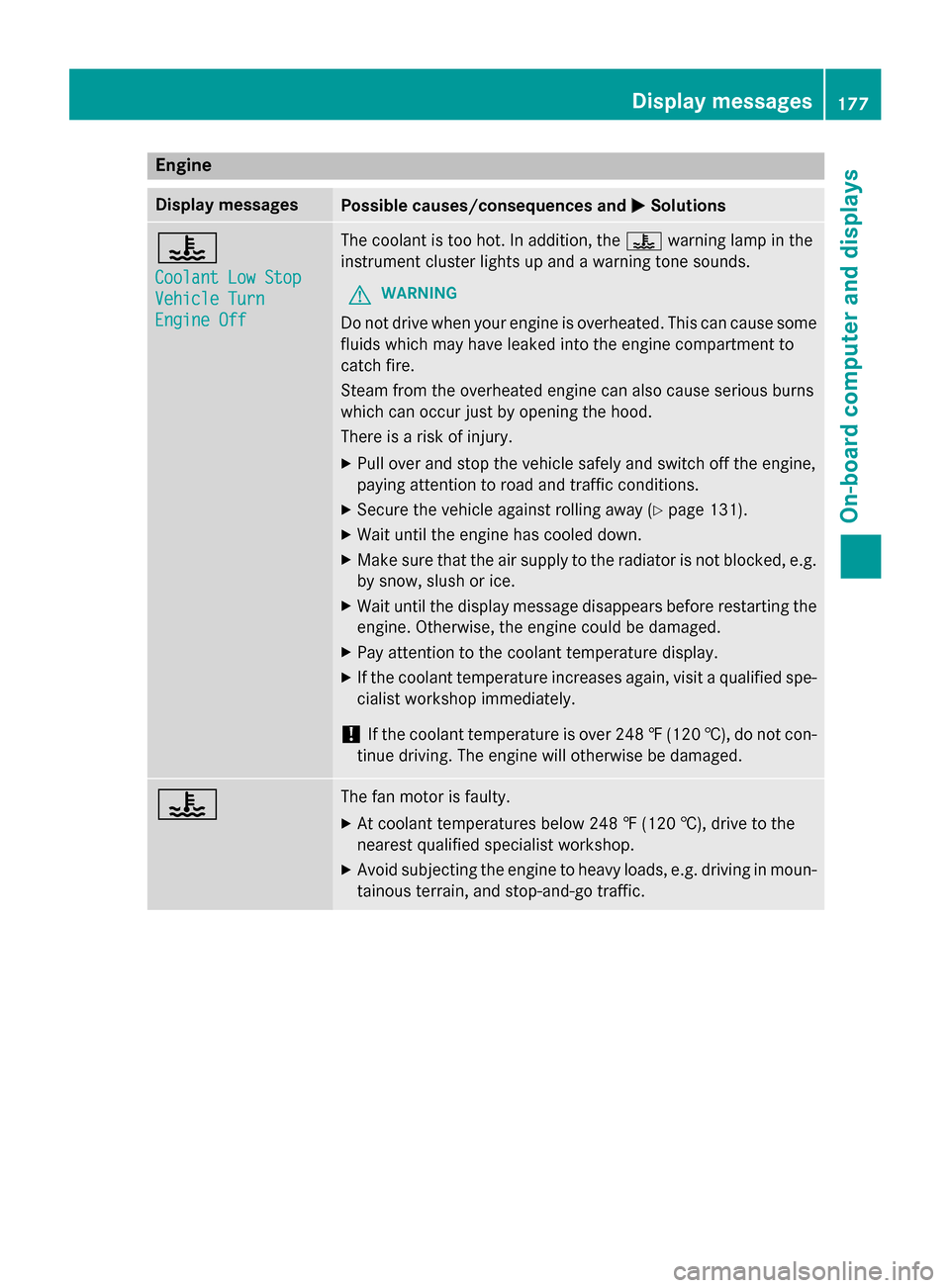
Engine
Display messages
Possible causes/consequences and
0050
0050Solutions 00AC
Coolan
tLow Stop
Coolan tLow Stop
Vehicl eTurn
Vehicl eTurn
Engine Off Engine Off The coolant is to
ohot.Ina ddition ,the 00AC warning lamp in the
instrumen tcluste rlight supa ndaw arning tone sounds.
G WARNING
Do no tdrivew hen your engin eisoverheated. This can caus esome
fluids whic hmay have leaked int othe engin ecompartmen tto
catch fire.
Steam from th eoverheate denginec an also caus eserious burns
whic hcan occur jus tbyopening th ehood.
Ther eisar isk of injury.
X Pull ove rand stop th evehicle safely and switch off th eengine,
paying attentio ntoroad and traffic conditions.
X Secure th evehicle against rolling away (Y page 131).
X Wait until th eengineh as cooled down.
X Mak esure that th eair supply to th eradiator is no tblocked, e.g.
by snow, slush or ice.
X Wait until th edisplay message disappears before restartin gthe
engine. Otherwise, th eenginec oul dbed amaged.
X Pay attentio ntothecoolant temperatur edisplay.
X If th ecoolant temperatur eincreases again ,visi taq ualifie dspe-
cialis tworkshop immediately.
! If th
ecoolant temperatur eisover2 48 ‡(120 †), do not con-
tinue driving. The engine will otherwise be damaged. 00AC The fan motor is faulty.
X At coolant temperatures below 248 ‡(120 †), drive to the
nearest qualified specialist workshop.
X Avoid subjecting the engine to heavy loads, e.g. driving in moun-
tainou sterrain, and stop-and-go traffic. Display messages
177On-board computer and displays Z
Page 180 of 290
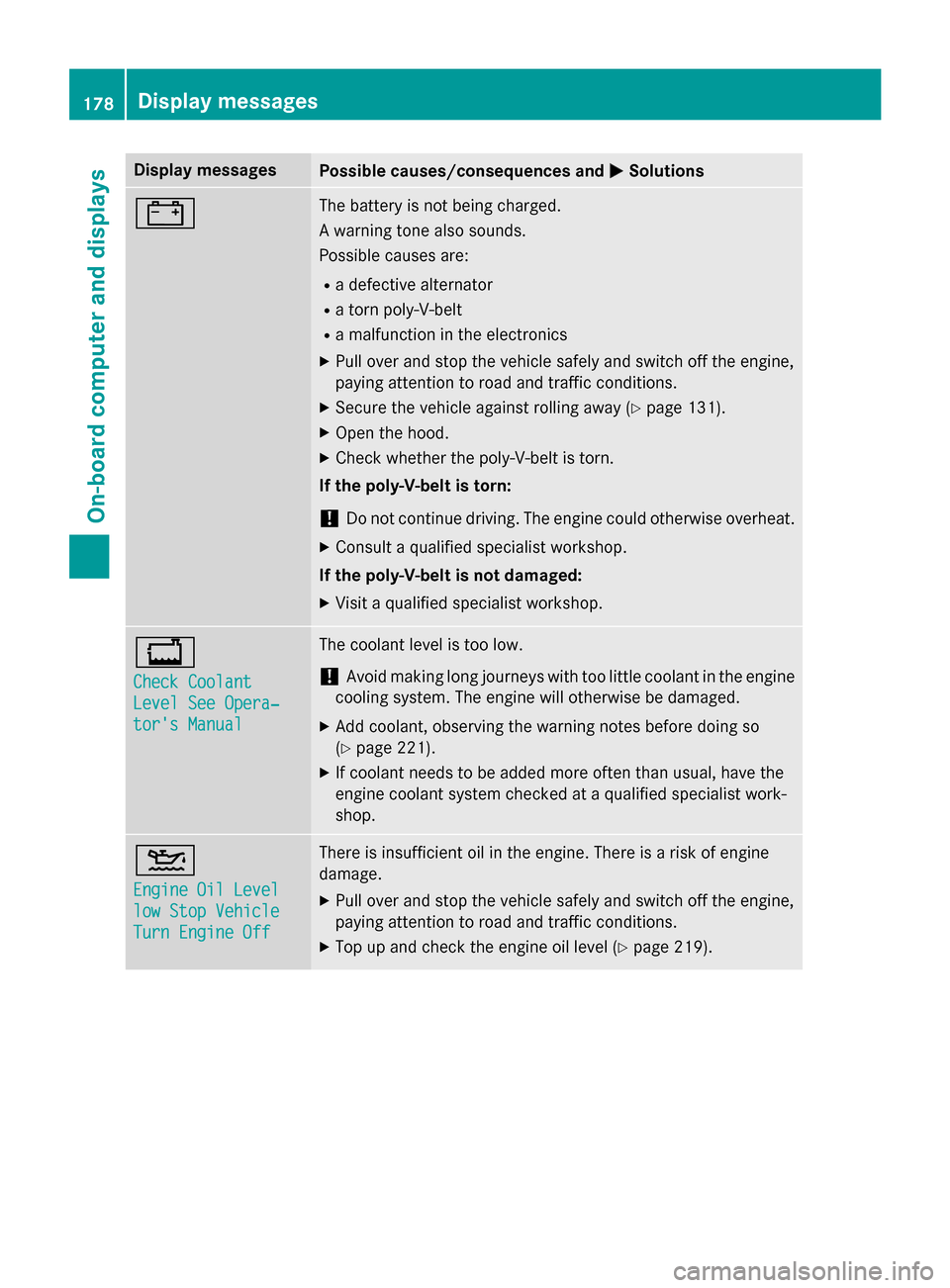
Display messages
Possible causes/consequences and
0050
0050Solutions 003D The battery is no
tbein gcharged.
Aw arnin gtonea lso sounds.
Possibl ecauses are:
R ad efective alternator
R at ornp oly-V-belt
R am alfunction in th eelectronics
X Pull ove rand stop th evehicl esafely and switch of fthe engine,
payin gattention to roa dand traffic conditions.
X Secur ethe vehicl eagainst rollin gaway (Y page 131).
X Ope nthe hood.
X Chec kwhether th epoly-V-belt is torn.
If th epoly-V-belt is torn:
! Do no
tcontinu edriving. The engin ecould otherwise overheat.
X Consult aqualified specialist workshop.
If th epoly-V-belt is not damaged:
X Visit aqualified specialist workshop. 00BD
Check Coolant Check Coolant
Level See Opera‐ Level See Opera‐
tor's Manual tor's Manual The coolan
tlevel is to olow.
! Avoid makin
glon gjou rneys wit htoo littl ecoolan tint heengine
coolin gsystem. The engin ewill otherwise be damaged.
X Ad dc oolant, observin gthe warnin gnotes before doin gso
( Ypage 221).
X If coolan tneeds to be added mor eoften than usual, hav ethe
engin ecoolan tsystem checke dataqualified specialist work-
shop. 00B2
Engine Oil Level Engine Oil Level
low Sto
pVehicle
low Sto pVehicle
Tur nE ngine Off
Tur nE ngine Off There is insufficien
toil in th eengine. There is ariskofe ngine
damage.
X Pull ove rand stop th evehicl esafely and switch of fthe engine,
payin gattention to roa dand traffic conditions.
X Top up and chec kthe engin eoil level (Y page 219). 178
Display
messagesOn-boardcomputer an ddisplays
Page 220 of 290
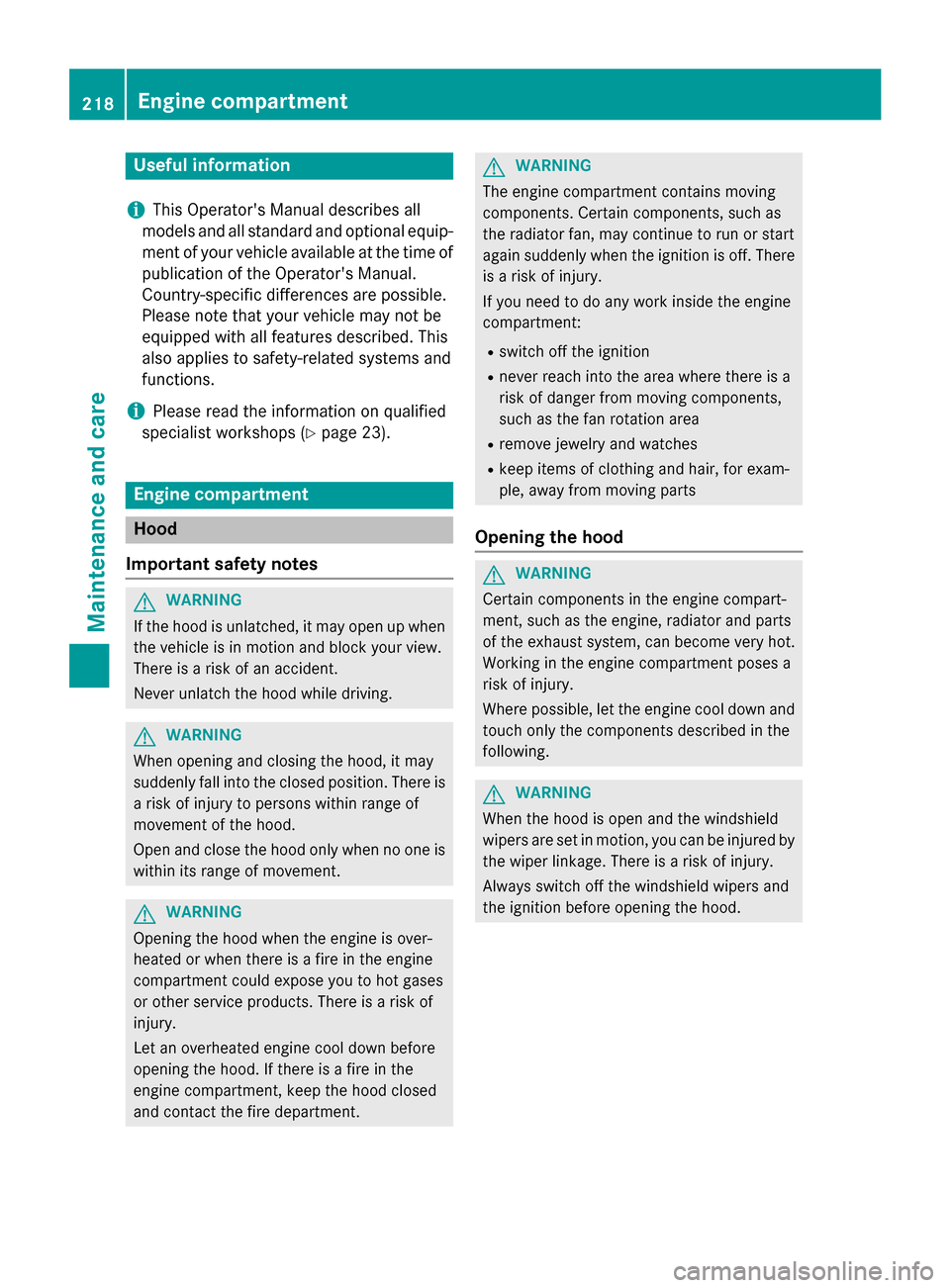
Useful information
i This Operator's Manual describes all
models and all standard and optional equip- ment of your vehicle available at the time of
publication of the Operator's Manual.
Country-specific differences are possible.
Please not ethat your vehicle may not be
equipped with all feature sdescribed. This
also applies to safety-related system sand
functions.
i Please read the information on qualified
specialist workshops (Y page 23).Engine compartment
Hood
Important safet ynotes G
WARNING
If the hood is unlatched, it may open up when the vehicle is in motion and block your view.
There is arisk of an accident.
Never unlatc hthe hood while driving. G
WARNING
When openin gand closin gthe hood, it may
suddenly fall int othe closed position .There is
ar isk of injury to person swithin range of
movement of the hood.
Open and close the hood only when no one is
within its range of movement. G
WARNING
Openin gthe hood when the engin eisover-
heated or when ther eisafire in the engine
compartmen tcould expose you to hot gases
or other servic eproducts. There is arisk of
injury.
Let an overheated engin ecool down before
openin gthe hood. If ther eisafire in the
engin ecompartment, keep the hood closed
and contact the fire department. G
WARNING
The engin ecompartmen tcontains moving
components. Certain components, such as
the radiator fan, may continue to run or start
again suddenly when the ignition is off. There is ar isk of injury.
If you need to do any work inside the engine
compartment:
R switc hoff the ignition
R neve rreach int othe area where ther eisa
risk of danger from movin gcomponents,
such as the fan rotation area
R remov ejewelry and watches
R keep items of clothing and hair, for exam-
ple, away from movin gparts
Opening the hood G
WARNING
Certain components in the engin ecompart-
ment ,such as the engine, radiator and parts
of the exhaust system ,can becom every hot.
Working in the engin ecompartmen tposes a
risk of injury.
Where possible, let the engin ecool down and
touc honly the components described in the
following. G
WARNING
When the hood is open and the windshield
wipers are set in motion, you can be injured by the wiper linkage. There is arisk of injury.
Always switc hoff the windshield wipers and
the ignition before openin gthe hood. 218
Engine compartmentMaintenance and care
Page 239 of 290
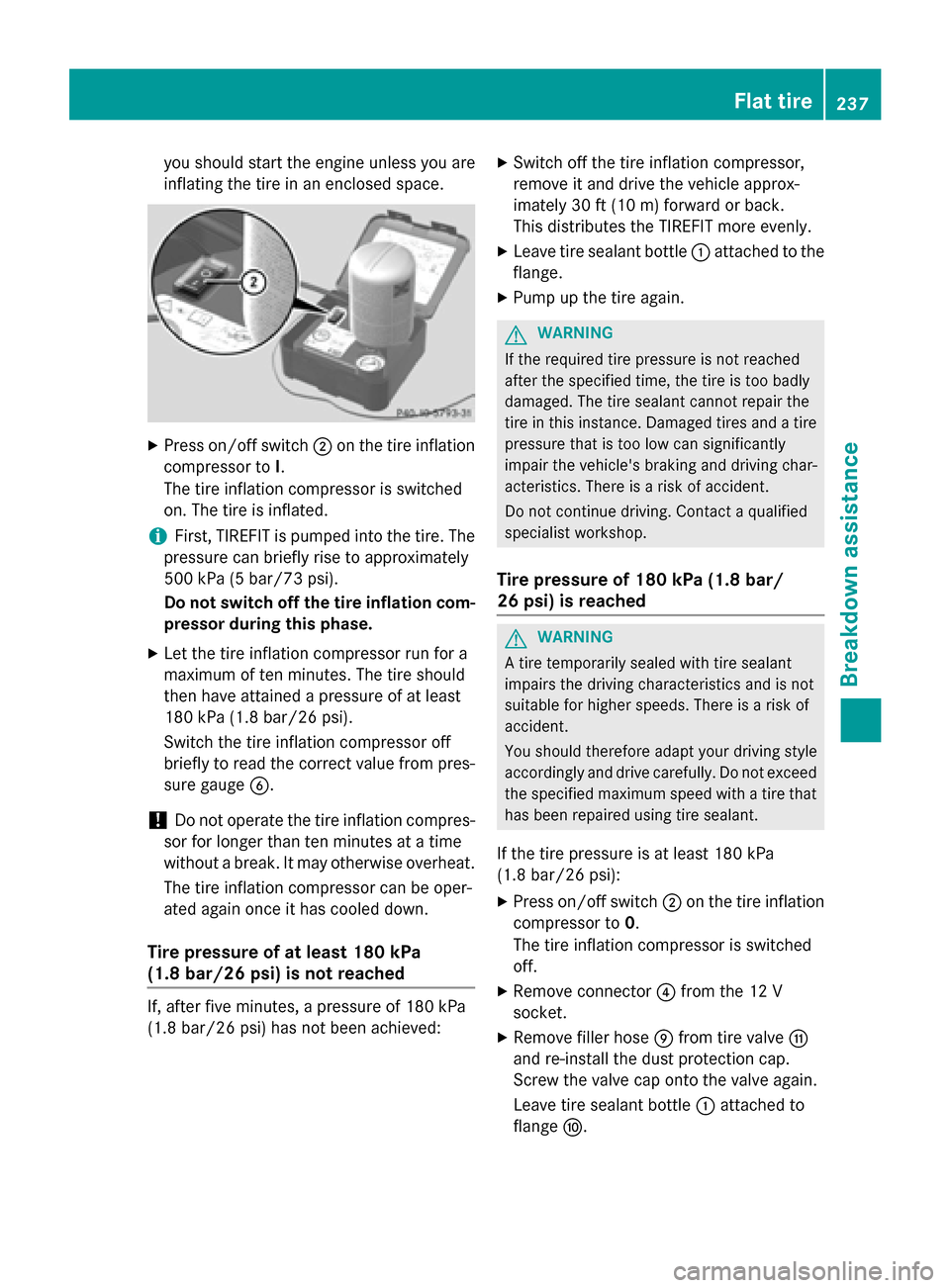
you should start th
eengineu nless you are
inflatin gthe tire in an enclosed space. X
Press on/off switch 0044on th etirei nflation
compressor to I.
The tire inflation compressor is switched
on .The tire is inflated.
i First
,TIREFI Tisp umped into th etire. The
pressur ecan briefl yrisetoa pproximately
50 0k Pa(5 bar/73 psi).
Do not switch off th etirei nflation com-
pressor during this phase.
X Let th etirei nflation compressor run fo ra
maximum of te nminutes. The tire should
then hav eattained apressur eofatl east
18 0k Pa (1.8 ba r/26psi).
Switch the tire inflation compressor off
briefly to read the correct value from pres- sure gauge 0084.
! Do not operate the tire inflation compres-
sor for longe rthan ten minute satatime
without abreak. It may otherwise overheat.
The tire inflation compressor can be oper-
ated again once it has coole ddown.
Tire pressure of at leas t180 kPa
(1.8 bar/2 6psi) is not reached If, after five minutes,
apressure of 180 kPa
(1.8 bar/26 psi )has not bee nachieved: X
Switch off the tire inflation compressor,
remove it and drive the vehicle approx-
imately 30 ft (10 m) forward or back.
Thi sd istributes the TIREFIT more evenly.
X Leave tire sealant bottle 0043attache dtothe
flange.
X Pump up the tire again. G
WARNING
If the required tire pressure is not reached
after the specified time, the tire is too badly
damaged. The tire sealant cannot repair the
tire in this instance. Damaged tires and atire
pressure that is too low can significantly
impair the vehicle's braking and driving char-
acteristics. There is arisk of accident.
Do not continue driving. Contact aqualified
specialist workshop.
Tire pressure of 180 kPa (1.8 bar/
26 psi) is reached G
WARNING
At ire temporarily sealed with tire sealant
impairs the driving characteristics and is not
suitabl efor higher speeds. There is arisk of
accident.
You should therefore adapt you rdriving style
accordingl yand drive carefully .Donot exceed
the specified maximu mspee dwithatire that
has bee nrepaired using tire sealant.
If the tire pressure is at least 180 kPa
(1.8 bar/26 psi): X Press on/off switch 0044on the tire inflation
compressor to 0.
The tire inflation compressor is switched
off.
X Remove connector 0085from the 12 V
socket.
X Remove filler hose 006Dfrom tire valve 006F
and re-instal lthe dus tprotectio ncap.
Screw the valve cap onto the valve again.
Leave tire sealant bottle 0043attache dto
flange 006E. Flat tire
237Breakdow nassistance Z